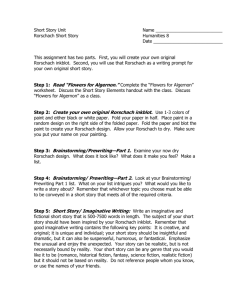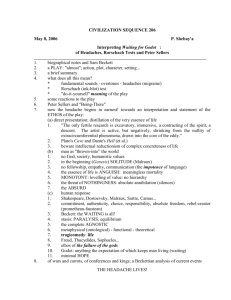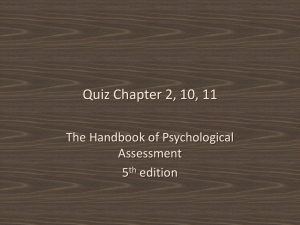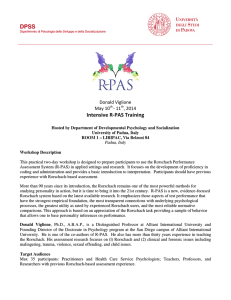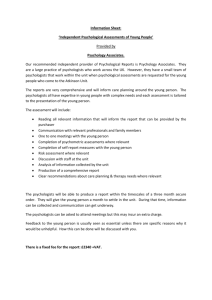Chapter 2a: Hermann Rorschach
advertisement
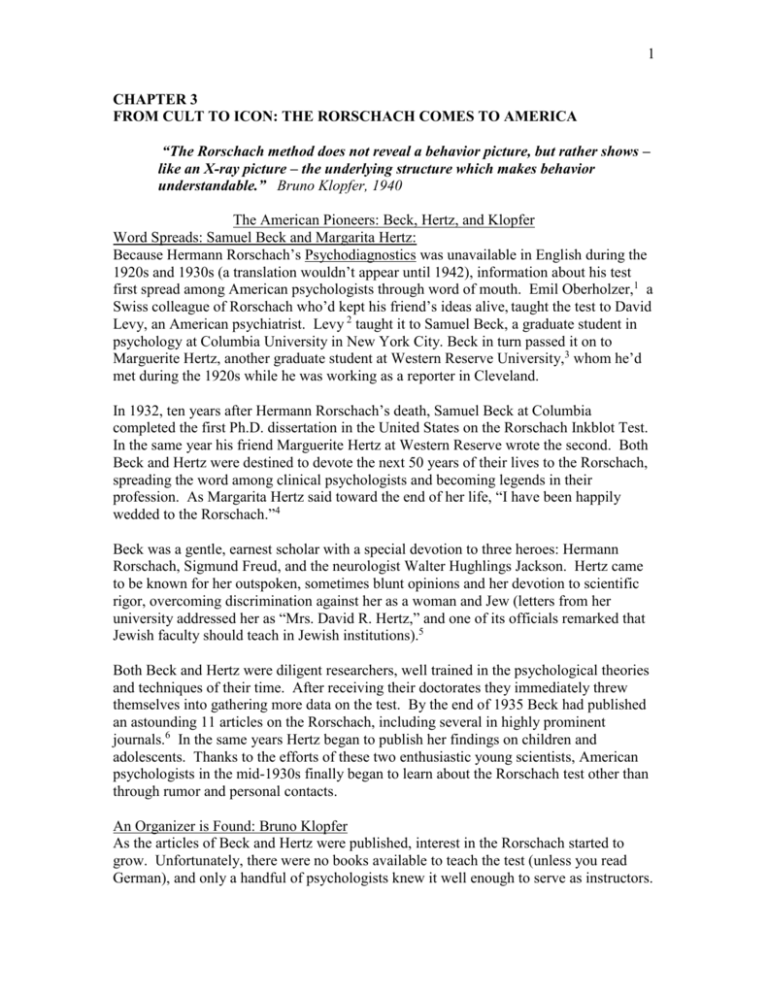
1 CHAPTER 3 FROM CULT TO ICON: THE RORSCHACH COMES TO AMERICA “The Rorschach method does not reveal a behavior picture, but rather shows – like an X-ray picture – the underlying structure which makes behavior understandable.” Bruno Klopfer, 1940 The American Pioneers: Beck, Hertz, and Klopfer Word Spreads: Samuel Beck and Margarita Hertz: Because Hermann Rorschach’s Psychodiagnostics was unavailable in English during the 1920s and 1930s (a translation wouldn’t appear until 1942), information about his test first spread among American psychologists through word of mouth. Emil Oberholzer,1 a Swiss colleague of Rorschach who’d kept his friend’s ideas alive, taught the test to David Levy, an American psychiatrist. Levy 2 taught it to Samuel Beck, a graduate student in psychology at Columbia University in New York City. Beck in turn passed it on to Marguerite Hertz, another graduate student at Western Reserve University,3 whom he’d met during the 1920s while he was working as a reporter in Cleveland. In 1932, ten years after Hermann Rorschach’s death, Samuel Beck at Columbia completed the first Ph.D. dissertation in the United States on the Rorschach Inkblot Test. In the same year his friend Marguerite Hertz at Western Reserve wrote the second. Both Beck and Hertz were destined to devote the next 50 years of their lives to the Rorschach, spreading the word among clinical psychologists and becoming legends in their profession. As Margarita Hertz said toward the end of her life, “I have been happily wedded to the Rorschach.”4 Beck was a gentle, earnest scholar with a special devotion to three heroes: Hermann Rorschach, Sigmund Freud, and the neurologist Walter Hughlings Jackson. Hertz came to be known for her outspoken, sometimes blunt opinions and her devotion to scientific rigor, overcoming discrimination against her as a woman and Jew (letters from her university addressed her as “Mrs. David R. Hertz,” and one of its officials remarked that Jewish faculty should teach in Jewish institutions).5 Both Beck and Hertz were diligent researchers, well trained in the psychological theories and techniques of their time. After receiving their doctorates they immediately threw themselves into gathering more data on the test. By the end of 1935 Beck had published an astounding 11 articles on the Rorschach, including several in highly prominent journals.6 In the same years Hertz began to publish her findings on children and adolescents. Thanks to the efforts of these two enthusiastic young scientists, American psychologists in the mid-1930s finally began to learn about the Rorschach test other than through rumor and personal contacts. An Organizer is Found: Bruno Klopfer As the articles of Beck and Hertz were published, interest in the Rorschach started to grow. Unfortunately, there were no books available to teach the test (unless you read German), and only a handful of psychologists knew it well enough to serve as instructors. 2 At Columbia University in 1934 a group of psychology graduate students tried to find a Rorschach teacher. Samuel Beck had moved away to Boston two years previously, but the students discovered that Bruno Klopfer, a research assistant in the Anthropology Department, knew how to administer and score the test. Though Klopfer himself had no great interest in the Rorschach, he agreed to meet with the students one night each week and teach them for a small fee. Klopfer was a Berlin psychologist who’d left his country in 1933 to escape the rising power of the Nazis. Attracted by the theories of C. G. Jung, the famous Swiss psychiatrist whose work had also influenced Hermann Rorschach, Klopfer moved to Zurich where he entered training under Jung and worked in a position that Jung had arranged for him. Considering Klopfer’s education and extensive experience, his Zurich job of administering and scoring psychological tests was humdrum and low-level. Although he learned to use the Rorschach while in Switzerland (the test had become fairly popular in the country of its birth), he was not particularly impressed with it. Less than a year after moving to Zurich, Klopfer managed to obtain a position as research assistant in the Anthropology Department at Columbia University in New York. Again, the job was not really a good fit with his interests and experience. However, the Great Depression was underway and Klopfer had a family to support. In all likelihood, he accepted the job at Columbia with the idea that he could eventually find work in America that was more suitable. When Klopfer began to meet with the graduate students from Columbia each week at his apartment, at first he intended to take a nuts-and-bolts approach, teaching them the basics of administering and scoring the Rorschach. However, the students soon complicated his task by pointing out that when they tried to score responses to the test, they often ran into problems that were difficult to resolve. For example, suppose a patient reported that one of the blots looked like “a man lying in a coffin.” Should this response be scored as M (Human Movement)? On the one hand, the word “lying” seemed to convey “passive movement,” which would be scored as M. On the other hand, the idea of a moving corpse seemed illogical. Other disagreements centered on the scoring of movement for animals or inanimate objects. If M responses were supposed to reflect a patient’s tendency to perceive movement where none was actually present, the graduate students asked, why shouldn’t responses like “a fish diving through the water” or “a rock smashing against a house” also be scored as M? Why was M restricted to images of humans only? Klopfer had to agree that such questions weren’t really resolved in Hermann Rorschach’s book. After all, Rorschach had intended Psychometrics as a research report, not a detailed instruction manual. Furthermore, a lecture given by Rorschach toward the end of his life and published posthumously in Switzerland in the early 1930s7 showed that he’d continued to tinker with the test after its publication, adding new scoring categories that were only vaguely defined.8 When Klopfer met with the graduate students, 3 disagreements abounded regarding both the scoring of these new categories and their psychological meaning. The classes at Klopfer’s apartment quickly evolved into lively meetings where the scoring and interpretation of the Rorschach test were debated and discussed, sometimes into the small hours of the morning. When additional graduate students from Columbia and New York University signed up, Klopfer added a second class, then a third. Based on his discussions with the students, he began to develop a large number of new scoring categories. By 1936 Klopfer had become the informal leader of a closely knit group of Rorschach enthusiasts. In that year he began to publish a mimeographed newsletter called the Rorschach Research Exchange, and in 1939 he formally established the Rorschach Institute, an organization of psychologists, social workers, and other professionals devoted to the test. Both the newsletter and the Institute thrived and eventually evolved into the present-day Journal of Personality Assessment and Society for Personality Assessment, which still retain their original purpose of studying and promoting the Rorschach. A magnetic speaker with an unusual capacity for establishing an empathetic connection with the people he met, Bruno Klopfer possessed exceptional talents as an organizer and proselytizer. Were it not for his organizational talents, the Rorschach Inkblot Test probably never would have become as popular, or as controversial, as it eventually did. In the next sections, we’ll take a deeper look at why the test exerted such a strong appeal for some psychologists in the 1930s, and why it aroused equally strong skepticism among others. The Appeal of the Rorschach The Young Profession of Clinical Psychology. At the time that the Rorschach first appeared in America, clinical psychology was still a tiny, embryonic profession, viewed askance by medical doctors and many psychologists who worked in universities.9 In the 1930s there were no graduate programs in clinical psychology. Any student who wished to become a clinical psychologist had to enroll in a general doctoral program in psychology and then supplement the regular coursework with classes and internships that would provide preparation for clinical work. The first clinical psychology clinic in the United States had been established at the University of Pennsylvania in1896. It focused on children with learning problems, and for the next 40 years clinical psychology was mainly a child-oriented profession, working with the mentally retarded, juvenile delinquents, and students with educational difficulties. When the first effective IQ tests were introduced into the United States by the psychologist Henry H. Goddard around 1910 (a story I’ll tell in more detail later in this chapter), the profession gained an important new tool that enhanced its prestige. As clinical psychologists began to use IQ tests to identify mentally retarded children, however, they often encountered fierce resistance from physicians, who took the position 4 that only medical doctors should diagnose mental retardation, and that psychologists who did so were practicing medicine without a license. Many psychologists who worked in universities also opposed the development of clinical psychology as a profession. These academic psychologists thought that the scientific base of psychology was still in its infancy (they were certainly correct), and that the time was too early to set up clinics and a separate profession of clinical psychology. They tended to believe that psychologists should devote themselves exclusively to research, and that the application of psychological discoveries to clinical work should wait until the science was more fully developed. So strong were the feelings on this issue that for many years the American Psychological Association was reluctant to admit clinical psychologists as members unless they were also active researchers who had published in scientific journals (?? check facts). Dissatisfaction With Self-Report Personality Tests During the 1920s and 1930s, clinical psychologists commonly worked with psychiatrists and social workers in child guidance clinics and centers for the treatment of juvenile delinquents. At first the psychologists’ main role was to administer IQ tests. However they soon began using personality tests as well, hoping to shed light on the emotional problems and motives of the children they were trying to help. The clinical psychologists faced an enormous practical difficulty, though, because the personality tests available in that era weren’t particularly helpful. Psychologists generally agreed about the definition of “intelligence” and how to measure it. In contrast, “personality” was considered a much vaguer concept, and there was no consensus about what it was or how it should be measured. College psychology departments usually didn’t even offer courses on personality in the 1920s and early 1930s.10 Most personality tests of the time were self-report inventories that asked a series of yes/no questions related to a single trait, such as sociability (“I like to relax by spending time with my friends”) or anxiety (“I tend to be a worrier”). In clinical settings, such inventories were viewed as less than satisfactory for several reasons.11 First, they relied on patients to accurately and honestly report their own behaviors, attitudes, and thoughts. But what about patients who were unwilling or unable to provide such information? Many people, whether patients or non-patients, are reluctant to discuss sensitive topics such as personal problems, sexual activities, or alcohol use. As one critic of self-report tests commented, the most important things about an individual are often what he cannot or will not say.12 The second problem with the self-report inventories of the 1920s and 1930s was their narrow focus. Typically they measured only a single trait or a few. Obviously clinical psychologists needed something more than the bare information that the child they were evaluating was “introverted” or “anxious.” The third problem with the inventories was their lack of depth: At most they described how a particular patient behaved, but without providing insight about why he or she acted that way.13 5 In the 1930s, many clinical psychologists wanted a personality test that did not depend on a patient’s own potentially unreliable self-descriptions, and that provided a full and complex picture of him or her as an individual. The Rorschach, particularly as it was reshaped by Bruno Klopfer, seemed to fit this need precisely. Whereas self-report inventories depended on what a patient was willing or able to reveal about himself or herself, Klopfer claimed that the Rorschach could operate like an x-ray14 and penetrate deep within the individual without his or her awareness. As an article in Klopfer’s Rorschach Research Exchange asserted, “It is just because the subject is not aware of what he is telling and has no cultural norms for hiding himself that the Rorschach and other projective methods are so revealing.”15 In addition, whereas most self-report inventories yielded scores for only one or two personality traits, Klopfer’s elaborate scoring system for the Rorschach yielded more than fifty.16 Poring over this wealth of data, a psychologist could weave together the various scores in the intuitive manner suggested by Klopfer, and produce a rich and nuanced portrait of a patient’s personality. Of course, “rich and nuanced” was not necessarily the same as “accurate,” and therein lay the seeds of a bitter dispute that soon arose among psychologists, eventually dividing two of the original Rorschach “pioneers,” Bruno Klopfer and Samuel Beck. At the same time that some psychologists in the 1930s were embracing the Rorschach as an amazingly sensitive psychological instrument, others began to express misgivings about the test and its enthusiastic promoters. To understand this resistance to the Rorschach, we need to realize that American psychologists had heard something similar once before. In the next section we’ll go back to the 1910s and 1920s, when IQ tests were first adopted in the U. S. with the same kind of enthusiasm that surrounded the Rorschach test in the 1930s. The hard and sobering lessons that American psychologists had learned from their misadventures with intelligence tests had prepared them to be cautious about the claims of Rorschach promoters. The Ups and Downs of Intelligence Testing: 1905 to 1930 Alfred Binet and the First Modern Intelligence Test The modern intelligence test originated in France nearly 100 years ago. The establishment of free public education in Europe and America during the 1800s had vastly increased the number and diversity of children in schools. In France as elsewhere, recognition grew that some “feebleminded” children (we would now say “mentally retarded” or “developmentally delayed”) could not learn as quickly as others and needed what is now called “special education.” Unfortunately, in the 1800s and early 1900s there was no good procedure for picking out the children with lower mental ability who needed special education. Teachers were often asked to identify the children in their classes whom they considered feebleminded. However (as I noted in the last chapter during my discussion of Hermann Rorschach’s research) informal estimates of intelligence tend to be poor. For example, a survey of Paris teachers revealed that they used widely different methods for estimating children’s 6 intellectual abilities. Many teachers mistakenly believed that a child’s facial expression or head shape was useful for estimating intelligence.17 Several American and European psychologists in the late 1800s had attempted to develop “mental tests” by measuring sensory and physical characteristics, such as muscular strength, reaction time, and sharpness of vision.18 In the 1890s, however, the French psychologist Alfred Binet began to experiment with a much different approach, asking children to perform tasks that required judgment, comprehension, and reasoning.19 For instance, a child might be asked to put together a simple puzzle, or to guess the word that had been left out of an incomplete sentence. Over a period of 15 years, working with hundreds of school children, Binet and his colleagues developed the first modern intelligence test, which was published in 1905 with revisions in 1908 and 1911. Like Rorschach, Binet died shortly after his test was developed and did not live to see how successful it would become.20 Henry Goddard and the Menace of Feeblemindedness Binet’s intelligence test was soon translated into English and published in the U. S. by Henry H. Goddard,21 a psychologist at the little-known Training School for FeebleMinded Girls and Boys in Vineland, New Jersey.22 At first, Goddard used the test to identify children who needed special education, classifying them according to their degree of intellectual deficiency: The most severely retarded children he classified as “idiots,” the moderately retarded as “imbeciles,” and the mildly retarded as “morons” (a term of Goddard’s own invention). His focus on retarded children was natural, since most clinical psychologists of that era worked with children who had educational problems. He soon achieved national recognition within his profession, publishing the highly regarded book Feeblemindedness. The Training School at Vineland began to offer summer courses for teachers, who learned to administer Binet’s intelligence test and imitate the School’s progressive educational practices. If Goddard’s had limited his work to developmentally delayed children, he would probably be regarded today as a benevolent figure and the most eminent American clinical psychologist of his time. Instead he is remembered as a wrong-headed idealist who embroiled the new field of intelligence testing in a disastrous controversy that has continued sporadically until the present day.23 Goddard taught that “feeblemindedness” was a hereditary condition responsible for myriad social ills, including crime, alcoholism, and prostitution. He warned that feebleminded people constituted a threat to the very moral fabric of America: “The feebleminded person is a menace to society at the present moment.”24 In his widely read book, The Kallikak Family, Goddard traced the history of two families, each of them descended from the same Revolutionary War soldier. On the one hand, the soldier had entered into an illicit liason with a “feeble-minded” barmaid. The offspring of this union down through later generations were characterized by drunkenness, crime, poverty, and madness. On the other hand, the soldier had married an upstanding Colonial woman of 7 good family. The descendants of this marriage were people of singular eminence and virtue, including government leaders, army officers, doctors, and ministers.25 Goddard’s history of the Kallikak family’s two branches was seriously flawed and biased. However, when first published in 1913, it had an enormous impact. Eugenics See also “By controlling the feebleminded, Goddard argued, the state would simultaneously reduce crime, poverty, prostitution, alcoholism, illegitimacy, and numerous other social ills.” p. 232 Set up summer classes spirit of teachers tested immigrants on Ellis Islandb Several of Rorschach’s Swiss colleagues continued to work on the test after his death, including Oberholzer, Walter Morganthaler, Hans Behn-Eschenburg and Georg Roemer. In the 1930s, Hans Binder ?? also became prominent. Although all four of these men made important contributions to the development of the Rorschach test, I confess (with apologies to my European colleagues), that I will not be discussing their work in depth. My focus is on the way that the Rorschach developed in the U. S. 2 Although prominent in the 1930s and 1940s, Levy is now seldom mentioned except for his relationship with Samuel Beck. Most books identify Levy as a psychiatrist. However, Margarita Hertz, who knew him personally, states that he was both a psychiatrist and a psychologist (Hertz, 1986, p.398). 3 Case Western Reserve (???) University. 4 Hertz (1986, p. 398) 5 Kessler (1994). 6 For a list of publications, see “Samuel Jacob Beck -- Citation” (1965) in Journal of Projective Techniques and Personality Assessment, 29, 414-417. 7 This lecture appears at the back of all English editions of Psychodiagnostics under the title “The Application of the Form Interpretation Test.” It also appears at the back of the second and all later German editions of the book (see remarks made in Walter Morganthaler’s “Preface to the Second Edition” of Psychodiagnostics (Rorschach,1921/1964, pp. 11-12). 8 Rorschach called these new variables “Chiaroscuro.” Today they would be classifed as Vista, Diffuse Shading, and perhaps Texture and Achromatic Color. 9 Excellent book-length histories of clinical psychology have been written by Reisman (1976) and Routh (1994). A briefer treatment is provided in a chapter by Hilgard (1987, pp. 615-661). 10 Hilgard, 1987, pp. 493-494 11 For negative comments on the self-report tests of that era, see Frank, 1939b, 1948; Hertz, 1986, p. 397. 12 Henry Murray, as paraphrased by Frank, 1939b, p. 395. 13 Hertz, 1986. 14 Klopfer (1940) 15 Frank (1939a, p. 104) 16 Klopfer & Kelley (1946) 17 Goodenough (1949, pp. 34-37) 18 Anastasi (1988, pp. 8-10) 19 Anastasi (1988, pp. 10-11) 20 Anastasi (1988, p. 11) 21 Goddard (1908, 1910); see also Hilgard (1987, pp. 463-466) 22 Although now well-known to many psychologists, the Vineland Training School was “obscure” before Henry Goddard established its reputation (Zenderland, 1998, p.2) 23 cite Gould, The Mismeasure of Man. I might want to take a look at that book and give a quote from Gould in the footnote. 24 Zenderland (1998, p. 232) 25 Add note, probably from Zenderland, also Goddard, regarding the Kallikak book. 1
